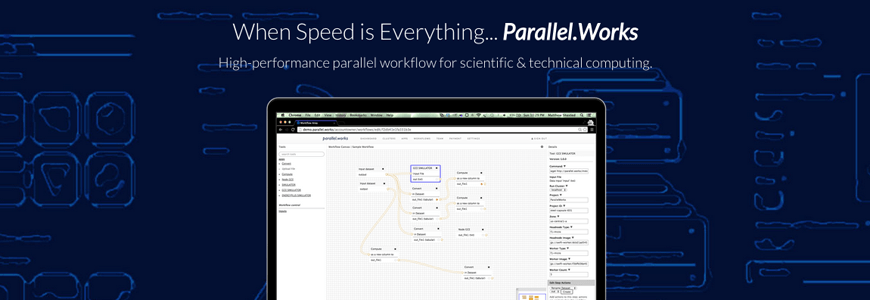By Rob Mitchum // February 6, 2015
More and more industries now use modeling and simulation as critical tools for engineering and design. But as the detail and scale of these simulations grows larger and larger, many companies hit a computational ceiling, unable to perform these advanced calculations as quickly as needed. With a boost from the Chicago Innovation Exchange, Parallel.Works, a new startup company from CI scientists, hopes to provide industries with parallel computing solutions to break through this barrier with a minimum of fuss.
Last month, Parallel.Works received a $120,000 vote of confidence from the CIE as one of this year’s recipients of the University of Chicago Innovation Fund. But the origin of Parallel.Works stretches back several years to the CI’s Swift parallel scripting language, an effort led by CI Senior Fellow Michael Wilde. Swift is a programming language designed to help scientists easily scale up their research software using parallel computing, and it has become an integral part of projects studying a broad range of topics from climate change to materials science to cities. Now Wilde and co-founder Matthew Shaxted hope a combination of Swift and other technologies can help businesses make faster discoveries as well.
“The product vision is based on the premise that there’s not as much systems-level parallel computing expertise out in the engineering and industrial science communities,” said Wilde, a software architect at Argonne National Laboratory. “Those companies and businesses are much more focused on their core domain and discipline and we want to create a solution that’s easy enough to use so that they’re not distracted from their core mission.”
Parallel computing is the simultaneous use of multiple CPU cores to speed up the completion of complex tasks, such as running thousands of copies of a simulation program to explore different design options for a building or product. The number of cores can range from the four-core chips found in newer laptops to the millions of cores available in supercomputers, depending on the size of the simulation. But scaling up a model that runs well on a personal computer to a supercomputer — or even to hundreds of cores purchased from a cloud provider — is not a trivial matter.
Currently, some scientists and industry tech experts hack their way through the process of creating a custom workflow that handles this large-scale parallelization. The vision of Parallel.Works is to make that process much simpler, with a browser-based online platform that makes setting up a cloud-based workflow and parallel computation as easy as using an app store.
“That jump from running your simulation once on a desktop to running a thousand copies on a parallel computing is a huge jump, and we want to make that jump easier for industrial engineering and science companies,” Wilde said.
Users can select from a menu of scientific models, either created by themselves or purchased from outside vendors, choose a cloud provider or local resource to run the calculations, and specify their sweet spot between completion speed and price. Workflows that connect incoming data with the chosen models and visualize results or export them to another machine can then be drawn and executed using simple drag-and-drop.
For example, an architect may want to test the energy demands for different designs of a new office building. Using her desktop computer, she can run a simulation for each design option, changing one parameter at a time — a problem when you’re dealing with large buildings or developments that may have thousands of design parameters. By designing a parallel workflow and renting compute cores from a cloud provider, those thousands of options can be simulated and evaluated simultaneously, accomplishing in hours what might have taken months on a desktop.
Parallel.Works makes this process happen by combining two products developed at the CI — Swift and data transfer service Globus — with an open-source workflow platform called Galaxy supported by a large community led by Emory and Penn State universities. Originally developed for genomics analysis, Galaxy has proven a versatile tool; the CI’s Center for Robust Decision-Making on Climate and Energy Policy adapted it for use in climate research built a portal named FACE-IT to make it available for that field. By incorporating Galaxy into Parallel.Works, Wilde and Shaxted see the platform expanding further for uses in areas ranging from pharmaceuticals to aerospace engineering to consumer product design — any industry for which simulation is used to optimize or test products.
“Parallel.Works is a perfect example of the innovative ideas being developed by University of Chicago and national laboratory researchers that have real commercial potential,” said John Flavin, executive director of the Chicago Innovation Exchange and member of the Innovation Fund advisory committee. “By taking advantage of the programs and resources available through the CIE and our partners, the team was able to learn more about the value of their idea and develop a plan for commercializing their technology. We’re looking forward to seeing Parallel.Works move their product along the pathway to the marketplace.”
The launch of Parallel.Works doesn’t mean the end of the Swift project, but instead, opens the door to a much broader audience and a longer future. Wilde hopes that the new company will help support Swift going forward, maintaining its open source status for the research community and allowing the project to live beyond the limits of its federal funding.
“Now we have an answer to the sustainability question — we can sustain Swift by productizing it and still aggressively maintaining it as an open source product,” Wilde said. “We think those two things can co-exist.”

